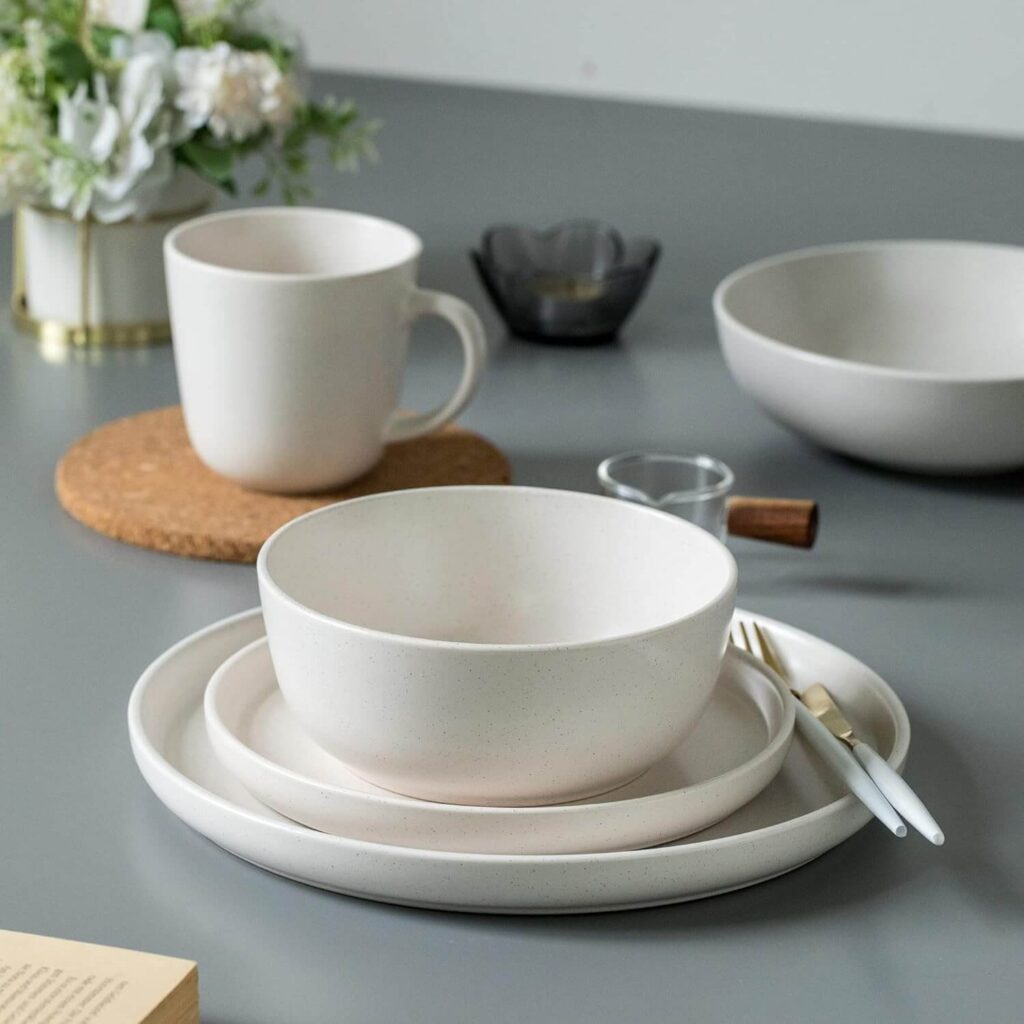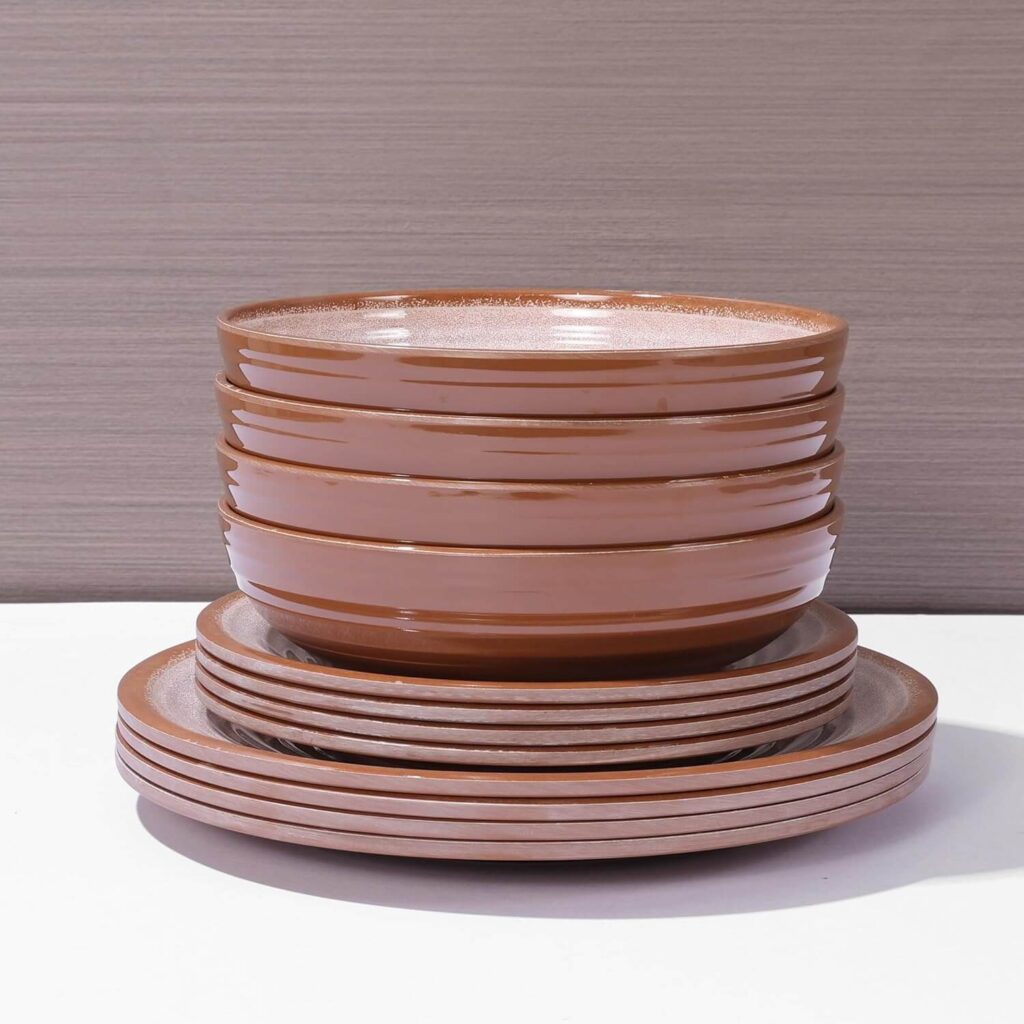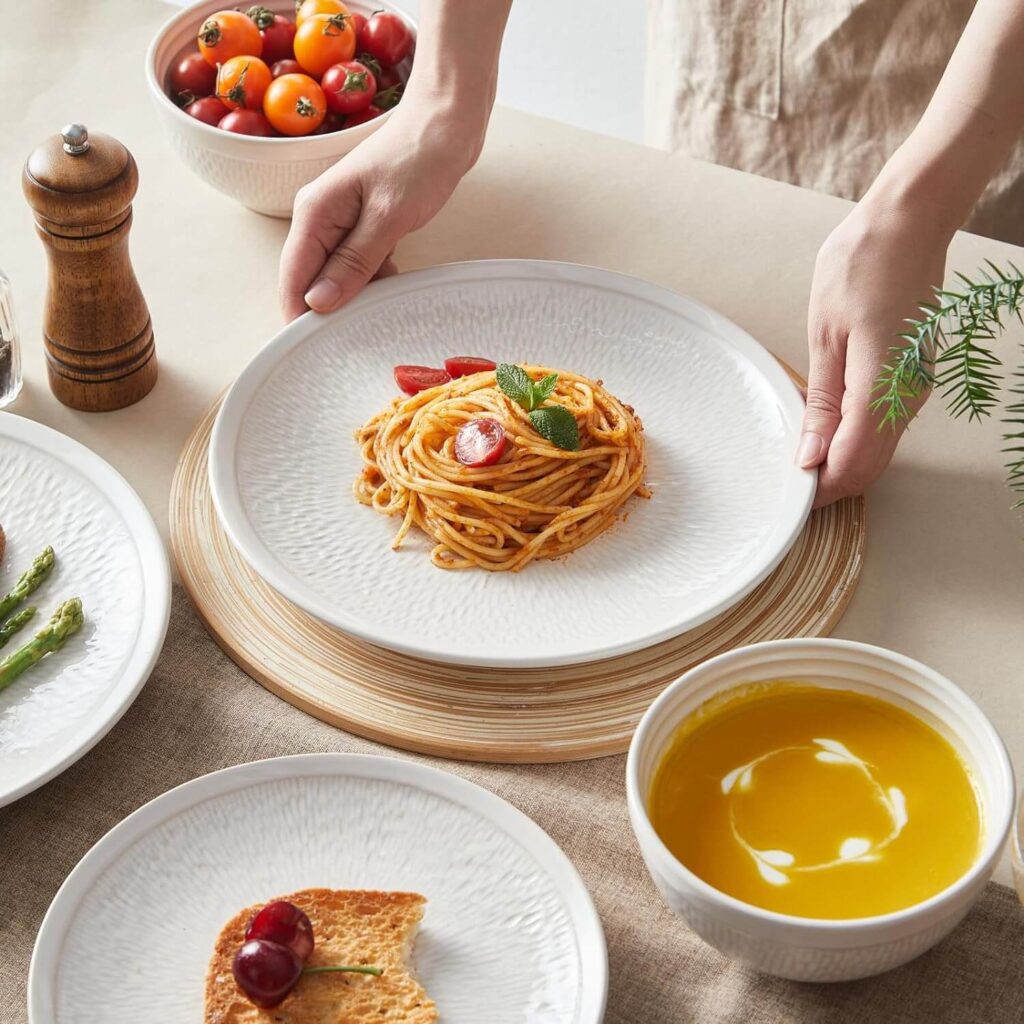Have you ever wondered which dinnerware material is tougher? When I was little, I couldn’t count how many of my favorite plates slipped from my hands and crashed to the floor.
I’m sure this is the same with you. Did yours survive the fall, or shatter into a million pieces?
There’s more than meets the eye when comparing stoneware and melamine durability.
These two popular materials have their unique strengths and weaknesses. Stoneware, with its classic look and feel, has been a staple in kitchens for centuries.
On the other hand, melamine has gained popularity for its lightweight and virtually unbreakable nature.
But which one truly stands the test of time and daily use? Let’s dive into the dinnerware world and uncover the truth about these two contenders.
COMPOSITION AND MANUFACTURING OF STONEWARE AND MELAMINE DINNERWARE
Stoneware and melamine dinnerware differ significantly in their composition and manufacturing processes.
Stoneware: Stoneware is a type of ceramic made from clay, feldspar, and quartz.
According to the American Ceramic Society (ACS), stoneware is fired at high temperatures between 2150°F and 2330°F (1177°C to 1277°C).
This high-temperature firing process vitrifies the clay, making it non-porous and durable.
The manufacturing process involves:
- Clay preparation
- Shaping (throwing, molding, or slip casting)
- Initial drying
- Bisque firing
- Glazing
- Final firing
Dr. William D. Kingery, a pioneer in materials science, extensively studied ceramic processes.
His work, detailed in the book “Ceramic Masterpieces: Art, Structure, and Technology,” provides insights into the complexities of stoneware production.
Melamine: Melamine dinnerware is made from melamine resin, a synthetic polymer. The FDA has guidelines for melamine-formaldehyde resins used in food contact articles.
The manufacturing process includes:
- Mixing melamine and formaldehyde to create the resin
- Adding colorants and fillers
- Pouring the mixture into molds
- Heating and pressing to shape and harden the material
Dr. Otto Bayer, who developed polyurethane chemistry, contributed significantly to the understanding of thermoset plastics like melamine.
COMPARING STONEWARE AND MELAMINE DURABILITY

In terms of durability, the choice depends on specific needs:
For example, if you are prioritizing longevity and versatility (oven/microwave use), stoneware’s heat resistance and ability to maintain appearance give it an edge.
For households with children or frequent entertaining, melamine’s resistance to breaking makes it more durable for daily use.
Ultimately, melamine is more durable against physical impacts and frequent handling, while stoneware offers better durability against heat and maintains its appearance longer.
The “better” choice depends on your specific needs and usage patterns.
IMPACT RESISTANCE COMPARISON OF STONEWARE AND MELAMINE DINNERWARE
Impact resistance is a crucial factor when comparing stoneware and melamine dinnerware. Let’s break down how each material performs under stress:

Stoneware: Stoneware has moderate impact resistance. While it’s more durable than earthenware, it can still chip or break when dropped.
The Mohs scale, developed by geologist Friedrich Mohs, rates stoneware’s hardness at about 7 out of 10. However, its brittleness makes it vulnerable to sudden impacts.
Dr. David Kingery, a renowned materials scientist, noted that the microstructure of fired stoneware affects its toughness.
The vitrification process creates a glass-like structure that resists scratches but can be prone to shattering.
Melamine: Melamine dinnerware boasts superior impact resistance. It’s often marketed as “virtually unbreakable” in normal use.
The polymer structure of melamine resin allows it to absorb and distribute impact energy effectively.
Polymer scientist Dr. Leo Baekeland’s work on thermosetting plastics laid the groundwork for materials like melamine.
The cross-linked structure of melamine resin gives it high impact strength and elasticity.

In industry testing, melamine typically outperforms stoneware in drop tests. However, it’s worth noting that while melamine resists breaking, it can scratch or dent over time.
The American Society for Testing and Materials (ASTM) provides standardized tests for dinnerware impact resistance, which manufacturers use to evaluate and compare different materials.
Remember, while melamine excels in impact resistance, stoneware often wins in areas like heat resistance and perceived quality. The choice between them depends on specific use cases and user preferences.
HEAT RESISTANCE
Heat resistance is a key factor distinguishing stoneware from melamine dinnerware:
Stoneware:

- Highly heat-resistant, withstanding temperatures up to 450°F (232°C)
- Safe for use in ovens, microwaves, and dishwashers
- Can handle hot foods and liquids without warping or melting
- Retains heat well, keeping food warm longer
Melamine:

- Limited heat resistance, typically safe up to 160°F (71°C)
- Not microwave or oven-safe
- Can warp or melt if exposed to high heat
- Should not be used with very hot foods or liquids
- Not recommended for serving soups or hot beverages
Key takeaways:
- Stoneware is versatile for both hot and cold foods
- Melamine is best suited for cold or room-temperature dishes
- For hot meals, stoneware is the safer choice
- Melamine’s heat limitations make it less versatile in the kitchen.
SCRATCH RESISTANCE
When thinking of which dinnerware to go for, you can’t rule out Scratch resistance because it is an important factor in the longevity and appearance of dinnerware.
Here’s how melamine and stoneware compare:
Melamine:
- Generally resistant to scratches from everyday use
- Can develop surface marks over time, especially from metal utensils
- Scratches are usually less noticeable due to the color consistency throughout the material
- May show wear more easily on darker colours or glossy finishes
Stoneware:
- Harder surface that resists scratching better than melamine
- Glazed surfaces provide additional scratch protection
- Can chip if subjected to strong impacts, potentially leading to scratches
- Scratches may be more visible on light-coloured or smooth glazes
Both materials offer good scratch resistance for daily use, but Stoneware typically performs better against scratches long-term.
Melamine may show wear faster, but is less likely to chip. The use of non-metal utensils can help preserve both materials.
Consider the visual impact of potential scratches when choosing colors and finishes
For best results, avoid cutting directly on either material and handle with care to maintain appearance over time.
LONGEVITY
Longevity comparison between stoneware and melamine dinnerware:
Stoneware:
- It can last for decades with proper care
- Resistant to fading and discoloration
- May chip or break if dropped, reducing the lifespan
- Glaze can craze (develop fine cracks) over time, but it doesn’t affect usability
- Retains its appearance and quality long-term
Melamine:
- Typically lasts 3-5 years with regular use
- Resistant to breaking, extending the practical lifespan
- Can become scratched or dull over time
- May absorb stains, especially from acidic foods
- More likely to need replacement due to aesthetic wear rather than breakage
Key factors affecting longevity:
- Usage frequency
- Care and handling
- Storage conditions
- Quality of the specific product
Overall:
- Stoneware has greater potential for long-term use
- Melamine offers consistent usability but may need earlier replacement due to wear
- Both can be long-lasting with proper care and handling
Choose based on your priorities: aesthetic longevity (stoneware) or functional durability (melamine).
MICROWAVE SAFETY: STONEWARE VS MELAMINE
Stoneware:
- Generally, microwave-safe
- May get hot in the microwave; use caution when handling
- Some glazes or decorations might not be microwave-safe
- Check the manufacturer’s instructions for specific pieces.
Melamine:
- Not microwave safe
- Can melt, warp, or release potentially harmful chemicals when heated
- Should never be used in microwave ovens
- Microwaving can damage the dinnerware and contaminate food.
For microwave reheating, stoneware is the only safe option between these two materials.
DISHWASHER RESISTANCE: STONEWARE VS MELAMINE
Stoneware:
- Generally, dishwasher safe
- Can withstand high temperatures and detergents
- May experience glaze wear over time with frequent dishwashing
- Hand-painted or special finishes might require hand-washing
Melamine:
- Dishwasher safe on top rack
- Resistant to chipping and breaking during wash cycles
- Can warp if exposed to high-heat drying cycles
- May become cloudy or lose shine over time with frequent dishwashing
Key points:
- Both materials are typically dishwasher-safe
- Stoneware handles high temperatures better
- Melamine should be placed on the top rack to avoid warping
- Frequent dishwashing may affect the appearance of both materials over time
- Always check the manufacturer’s recommendations for specific care instructions
Overall, both materials offer good dishwasher resistance, with stoneware having a slight edge in heat tolerance.
MAINTENANCE AND CARE OF STONEWARE AND MELAMINE
Stoneware:
- Hand wash or use the dishwasher
- Avoid sudden temperature changes to prevent cracking
- Use soft sponges to clean; avoid abrasive scrubbers
- Safe to use metal utensils, but can cause marks
- Store carefully to prevent chipping
Melamine:
- Dishwasher safe (top rack recommended)
- Hand wash with mild soap and a soft cloth
- Avoid abrasive cleaners and scrubbers
- Don’t use metal utensils to prevent scratching
- Store stacked or nested; resistant to chipping
Both:
- Rinse or wipe soon after use to prevent staining
- Soak stubborn stains in warm, soapy water
- Dry thoroughly before storing
- Avoid cutting directly on the surface
Key differences:
- Stoneware requires more careful handling to prevent breakage
- Melamine needs protection from high heat and sharp objects
- Stoneware can handle more aggressive cleaning if needed
- Melamine is more prone to surface wear over time
Choose based on your lifestyle and willingness to maintain.
COST-EFFECTIVENESS OVER TIME USING STONEWARE AND MELAMINE DINNERWARE
Initial Cost:
– Stoneware: Higher upfront cost. Example: A 16-piece set typically ranges from $22 to $100+, depending on the brand.
– Melamine: Lower initial investment. Example: A 16-piece set often costs between $20 to $80.
Longevity:
– Stoneware: Can last decades with proper care. Many families pass down stoneware sets.
– Melamine: Average lifespan of 3-5 years with regular use before showing significant wear.
Replacement Frequency:
– Stoneware: Rarely needs a full set replacement. Individual pieces may need replacing if broken.
– Melamine: Entire sets are often replaced every few years due to scratches, stains, or fading.
Additional Considerations:
– Stoneware retains value and appearance over time.
– Melamine may require more frequent purchases but offers flexibility for changing styles.
Conclusion:
While melamine has a lower upfront cost, stoneware often proves more cost-effective over time due to its longevity and lower replacement needs.
Choose based on your budget, lifestyle, and long-term value preferences.
COMPARISON OF STONEWARE AND MELAMINE DINNERWARE: HOME VS. COMMERCIAL USE
Stoneware for Home Use:
– Durability: Excellent for daily family use; resistant to chips and scratches
– Aesthetics: Wide range of designs; adds elegance to table settings
– Versatility: Oven-safe; suitable for cooking, serving, and storage
– Maintenance: Dishwasher-safe; may require occasional hand-washing for intricate designs
Melamine for Home Use:
– Durability: Shatter-resistant; ideal for households with children
– Practicality: Lightweight; easy to handle and store
– Aesthetics: Vibrant colors and patterns; casual appearance
– Limitations: Not microwave-safe; can warp if exposed to high heat
Stoneware Commercial Use:
– Durability: Withstands frequent use in restaurants; heat-resistant
– Presentation: Elevates dining experience in upscale establishments
– Cost: Higher initial investment; longer lifespan offsets costs
– Maintenance: Requires careful handling; more prone to breakage in busy environments
Melamine Commercial Use:
– Durability: Highly resistant to breakage; ideal for high-volume establishments
– Efficiency: Lightweight; reduces server fatigue and risk of accidents
– Cost-effectiveness: Lower initial cost; frequent replacement may increase long-term expenses
– Sanitation: Non-porous surface inhibits bacterial growth; meets FDA food safety standards
According to Chef Thomas Keller, “In professional kitchens, we often use a combination of stoneware for plating and melamine for prep work and casual dining areas.”
The National Restaurant Association reports that 78% of fast-casual restaurants prefer melamine for its durability and cost-effectiveness.
Environmental Considerations of Stoneware and Melamine Dishes:
– Stoneware: Eco-friendly; biodegradable and recyclable.
– Melamine: Not biodegradable; concerns about environmental impact.
Finally, we recommend stoneware dinnerware for home use and upscale dining where design/beauty and versatility are priorities.
Opt for melamine in commercial settings with high turnover and casual dining environments.
Consider the balance between initial cost, longevity, and specific operational needs when making a decision.
CONCLUSION
In conclusion, the durability comparison between stoneware and melamine reveals distinct advantages for each material.
Stoneware excels in heat resistance, longevity, and scratch resistance, making it ideal for long-term use in various settings.
Its ability to withstand high temperatures and maintain its appearance over time gives it an edge in both home and upscale commercial environments.
Melamine, on the other hand, offers superior impact resistance and lightweight properties, making it a practical choice for high-traffic commercial settings and households with children.
While melamine is more prone to scratches and has limitations with heat, its shatter-resistant nature provides a significant advantage in busy environments.
Ultimately, the choice between stoneware and melamine depends on specific needs, balancing factors such as intended use, design preferences, and long-term cost-effectiveness.
Both materials have their place in the market, catering to different priorities in durability and functionality.